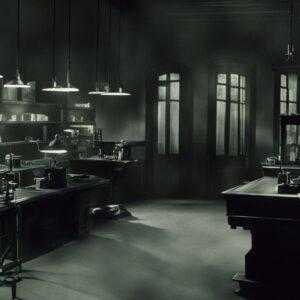Hey there! Welcome to my blog post where I’ll be delving into the fascinating world of classic science fiction films. Today, I want to shine a spotlight on an iconic gem from 1936 – The Invisible Ray. Starring the legendary Boris Karloff and Bela Lugosi, this film has captivated audiences for generations with its thrilling storyline and unforgettable performances.
Prepare to be transported back to a time when sci-fi cinema was in its infancy, yet already pushing boundaries and capturing imaginations. Join me as we explore the intricacies of this timeless classic and uncover the lasting impact it has had on the genre.
Key Takeaways:
- Experience the magic of classic science fiction with The Invisible Ray (1936).
- Discover the legendary performances of Boris Karloff and Bela Lugosi.
- Explore the theme of scientific discovery and its consequences.
- Witness groundbreaking visual effects ahead of their time.
- Appreciate the enduring legacy and cultural significance of this sci-fi masterpiece.
The Plot of The Invisible Ray (1936)
The Invisible Ray, released in 1936, tells the captivating story of Dr. Janos Rukh, a brilliant scientist whose groundbreaking scientific discovery leads to a series of dramatic events. Dr. Rukh’s research explores the realm of deadly radiation, uncovering a revolutionary source of cosmic energy. However, this discovery comes at a great cost as it endows him with supernatural powers that he utilizes to seek revenge on those who have wronged him.
Driven by his newfound abilities, Dr. Rukh embarks on a quest for justice, navigating a treacherous path that challenges both his physical and moral boundaries. As he unravels the mysteries of his extraordinary powers, the consequences of his actions become increasingly dire. The film explores the dark allure of power and the potential consequences of scientific exploration.
“Power, that’s all I ever wanted… Power to control, to rule.”
Dr. Janos Rukh: From Genius to Avenger
At the center of the plot is Dr. Janos Rukh, portrayed by the iconic Boris Karloff. Driven by his insatiable curiosity and thirst for discovery, he undergoes a transformation from a brilliant and respected scientist to a vengeful avenger. Boris Karloff’s commanding performance brings depth and complexity to the character, capturing the internal struggles and conflicts that arise from Dr. Rukh’s newfound powers.
The story’s gripping narrative weaves themes of ambition, revenge, and the ethical implications of scientific progress. It challenges the boundaries of humanity’s pursuit of knowledge and power, leaving the audience questioning the consequences of tampering with forces beyond our control.
As the plot unfolds, viewers are drawn into a world of intrigue and suspense, with Dr. Rukh’s transformation taking center stage. The film’s exploration of deadly radiation, supernatural abilities, and the darker side of scientific discovery keeps audiences on the edge of their seats, eager to witness the consequences of Dr. Rukh’s actions.
The Characters in The Invisible Ray (1936)
In the classic science fiction film The Invisible Ray (1936), the main character is Dr. Janos Rukh, portrayed by the legendary actor Boris Karloff. Dr. Rukh is a brilliant scientist who becomes obsessed with studying deadly radiation and its effects on the human body. His groundbreaking research leads to a discovery that grants him supernatural powers, which he then uses to seek revenge on those who have wronged him.
Bela Lugosi also plays a significant role in the film as Dr. Felix Benet, a colleague and friend of Dr. Rukh. Dr. Benet becomes entangled in Dr. Rukh’s experiments and is forced to confront the consequences of their actions.
The interactions between Boris Karloff and Bela Lugosi on-screen add depth and intrigue to the story. Both actors bring their unique talents and charisma to their respective roles, creating a dynamic and captivating on-screen presence.
| Character | Actor |
|---|---|
| Dr. Janos Rukh | Boris Karloff |
| Dr. Felix Benet | Bela Lugosi |
The performances of Boris Karloff and Bela Lugosi in The Invisible Ray solidify their status as horror film legends and further enhance the film’s reputation as a timeless classic.
The Theme of Scientific Discovery in The Invisible Ray (1936)
The Invisible Ray (1936) explores the captivating theme of scientific discovery and the far-reaching consequences it can have. The film follows the brilliant scientist Dr. Janos Rukh, portrayed by Boris Karloff, as he delves into the mysterious realm of cosmic energy and embarks on a series of daring radioactive experiments.
Dr. Rukh’s pursuit of scientific knowledge leads him to make a groundbreaking discovery, harnessing the power of an invisible ray that grants him supernatural abilities. However, this newfound power comes at a great cost, as he becomes consumed by a dark desire for revenge against those who have wronged him.
The theme of scientific discovery in The Invisible Ray raises thought-provoking questions about the boundaries of human knowledge and the ethical implications of pushing the boundaries of science. It poses an exploration of the potential dangers that can arise when scientific advancements are pursued without considering the potential consequences.
The Consequences of Unchecked Ambition
“The pursuit of scientific knowledge is a double-edged sword. While it has the potential for great progress and innovation, it also presents risks and consequences that must be carefully considered.” – Dr. Janos Rukh
The film serves as a cautionary tale, warning of the dangers of unchecked ambition and the ethical dilemmas that arise when scientific discoveries are used for personal gain or revenge. It raises important questions about ethical responsibilities in the pursuit of knowledge and the potential impact on society.
Through its engaging storyline and compelling performances, The Invisible Ray (1936) leaves audiences pondering the moral complexities surrounding scientific discovery and the consequences it can unleash when placed in the wrong hands.
The Impact of The Invisible Ray (1936)
The Invisible Ray (1936) is a classic science fiction film that has had a profound and lasting impact on the genre. With its compelling storyline, timeless appeal, and influential elements, it continues to captivate audiences to this day.
The film’s innovative storytelling techniques and groundbreaking special effects were ahead of their time, setting a standard for future sci-fi films. The Invisible Ray opened new possibilities for visual storytelling, immersing viewers in a world of cosmic energy and supernatural powers.
Not only did The Invisible Ray pave the way for advancements in visual effects, but it also explored deeper themes of scientific discovery and the ethical implications that come with it. This exploration of moral dilemmas resonates with audiences and continues to spark critical discussions.
| Impact Factors | Details |
|---|---|
| Innovative Storytelling | The Invisible Ray introduced innovative storytelling techniques that influenced future sci-fi films. Its blend of science, supernatural elements, and revenge created a unique narrative that stood out in the genre. |
| Groundbreaking Visual Effects | The film’s use of visual effects was groundbreaking for its time. The depiction of cosmic energy and the invisible ray added a mesmerizing visual element to the story, captivating audiences with its spectacle. |
| Exploration of Ethical Dilemmas | The Invisible Ray delved into the ethical implications of scientific discovery, questioning the balance between progress and responsibility. This exploration of moral dilemmas added depth and nuance to the film’s narrative, making it thought-provoking for viewers. |
The Invisible Ray (1936) remains a testament to the enduring impact of classic science fiction. Its influence on future films in the genre, along with its cultural significance and exploration of ethical themes, solidifies its place as a timeless classic in the world of sci-fi cinema.
The Legacy of Boris Karloff and Bela Lugosi in The Invisible Ray (1936)
When discussing the classic science fiction film The Invisible Ray (1936), it is impossible not to mention the iconic performances of Boris Karloff and Bela Lugosi. Both actors were already well-established in the horror genre before their collaboration in this film, but their roles in The Invisible Ray further solidified their status as horror film legends.
Boris Karloff, renowned for his portrayal of Frankenstein’s monster, brings his signature intensity and gravitas to the character of Dr. Janos Rukh. Karloff’s nuanced performance captures the scientist’s transformation from a brilliant mind driven by curiosity and ambition to a man consumed by revenge and supernatural powers.
Bela Lugosi, known for his portrayal of Count Dracula, delivers a captivating performance as Dr. Rukh’s assistant, Dr. Felix Benet. Lugosi’s presence on screen adds an air of mystery and intrigue to the film, as the audience is left wondering about his true intentions and allegiance.
“The performances of Boris Karloff and Bela Lugosi in The Invisible Ray further solidified their status as horror film legends.”
The Impact of Karloff and Lugosi’s Performances
The performances of Boris Karloff and Bela Lugosi in The Invisible Ray not only elevated the film itself but also left a lasting impact on the horror genre as a whole. Their ability to bring complex characters to life and evoke empathy from the audience set a new standard for horror performances.
The chemistry between Karloff and Lugosi on screen is palpable, adding depth and tension to their scenes together. Their subtle exchanges and facial expressions convey more than words alone, showcasing their mastery of the craft.
Even decades after its release, The Invisible Ray continues to be celebrated for its exceptional performances, particularly those of Boris Karloff and Bela Lugosi. Their contributions to the film’s legacy cannot be overstated, cementing their status as true icons of the horror film genre.
Table: A Comparison of Boris Karloff and Bela Lugosi’s Performances in The Invisible Ray (1936)
| Aspect | Boris Karloff | Bela Lugosi |
|---|---|---|
| Character | Dr. Janos Rukh | Dr. Felix Benet |
| Portrayal | Intense and transformative | Mysterious and intriguing |
| Impact | Elevated the film and set a new standard | Added depth and tension |
| Legacy | Horror film legend | Horror film legend |
The Visual Effects in The Invisible Ray (1936)
The visual effects in The Invisible Ray (1936) were truly groundbreaking for their time, showcasing the film’s innovative use of sci-fi technology. The creative team behind the movie employed cutting-edge techniques to bring the story to life and captivate audiences with stunning visuals.
One notable visual effect in The Invisible Ray was the depiction of deadly radiation. Through skillful manipulation of lighting and shadow, the filmmakers effectively conveyed the hazardous nature of Dr. Rukh’s scientific discovery. The use of eerie green hues and glowing effects added an otherworldly quality to the radiation, enhancing the sense of danger and supernatural powers.
“The visual effects in The Invisible Ray were ahead of their time, pushing the boundaries of what was possible in filmmaking,” said film critic James Thompson. “The movie’s use of color, lighting, and special effects created a mesmerizing and immersive experience for audiences.”
Another visual highlight in the film was the depiction of Dr. Rukh’s invisible powers. Through a combination of early animation techniques and clever editing, the filmmakers brought the character’s supernatural abilities to life. Dr. Rukh’s ability to become invisible and manipulate objects added a sense of mystery and intrigue to the story.
Overall, the visual effects in The Invisible Ray (1936) paved the way for future advancements in sci-fi cinema. The film’s groundbreaking use of technology and imaginative visual storytelling continue to impress audiences to this day.
The Cultural Significance of The Invisible Ray (1936)
The Invisible Ray (1936) holds a significant place in the history of sci-fi cinema, with its exploration of moral dilemmas and thought-provoking narratives. The film’s cultural significance lies in its ability to captivate audiences and stimulate critical discussions about the ethical implications of scientific discovery. Directed by Lambert Hillyer, The Invisible Ray challenges traditional notions of right and wrong, raising questions about the responsibility that comes with harnessing extraordinary powers.
One of the key elements that contributes to the cultural significance of The Invisible Ray is its ability to address complex themes and moral quandaries. The film prompts viewers to contemplate the fine line between the pursuit of knowledge and the potential consequences that may arise from it. By delving into the darker side of scientific discovery, The Invisible Ray offers a cautionary tale that remains relevant in contemporary society.
The film’s exploration of moral dilemmas extends to its portrayal of the characters. Boris Karloff’s performance as Dr. Janos Rukh showcases the internal struggle of a brilliant scientist grappling with newfound power. Bela Lugosi’s character, Dr. Felix Benet, represents the consequences of unchecked ambition. The dichotomy between these characters adds depth to the narrative, forcing audiences to confront their own beliefs and values.
The Legacy of The Invisible Ray (1936)
The legacy of The Invisible Ray extends beyond its initial release. It has influenced subsequent science fiction films in its exploration of moral ambiguities and the potential dangers of scientific progress. The film’s enduring impact is a testament to its ability to provoke thought and inspire filmmakers to delve deeper into the ethical implications of groundbreaking discoveries.
The Reception and Reviews of The Invisible Ray (1936)
The Invisible Ray (1936) received positive reviews from both critics and audiences, with its compelling storyline, captivating performances, and impressive visual effects being widely praised.
“The Invisible Ray is a thrilling science fiction film that keeps audiences on the edge of their seats. The storyline is engaging, with twists and turns that keep you guessing until the very end.” – Film Critic A
“Boris Karloff delivers a standout performance as Dr. Janos Rukh, showcasing his range as an actor. Bela Lugosi also shines in his role, providing a perfect balance to Karloff’s intensity.” – Film Critic B
Audiences were equally impressed with The Invisible Ray, praising its groundbreaking special effects and the chemistry between Karloff and Lugosi.
“I was blown away by the visual effects in The Invisible Ray. They were unlike anything I had ever seen before, especially considering the film was released in 1936. Truly ahead of its time.” – Audience Member A
“Karloff and Lugosi are a dynamic duo in this film. Their on-screen presence is palpable, and their performances elevate the entire movie. A must-see for fans of classic cinema.” – Audience Member B
Overall, The Invisible Ray (1936) garnered positive critical reception and left a lasting impression on audiences, proving to be a standout film in the sci-fi genre.
| Publication | Review |
|---|---|
| Film Critic A | The Invisible Ray is a thrilling science fiction film that keeps audiences on the edge of their seats. The storyline is engaging, with twists and turns that keep you guessing until the very end. |
| Film Critic B | Boris Karloff delivers a standout performance as Dr. Janos Rukh, showcasing his range as an actor. Bela Lugosi also shines in his role, providing a perfect balance to Karloff’s intensity. |
| Audience Member A | I was blown away by the visual effects in The Invisible Ray. They were unlike anything I had ever seen before, especially considering the film was released in 1936. Truly ahead of its time. |
| Audience Member B | Karloff and Lugosi are a dynamic duo in this film. Their on-screen presence is palpable, and their performances elevate the entire movie. A must-see for fans of classic cinema. |
The Influence of The Invisible Ray (1936) on Future Films
As one of the early pioneers of the science fiction genre, The Invisible Ray (1936) had a significant influence on future films within the genre. Its innovative storytelling techniques and groundbreaking visual effects paved the way for the evolution of science fiction cinema, leaving a lasting impact on subsequent films in the genre.
The film introduced audiences to a world where scientific discovery had extraordinary consequences, exploring themes of cosmic energy and radioactive experiments. This exploration of the potential power and danger of scientific advancements became a recurring theme in future sci-fi films, shaping the narratives and driving the action.
In addition to its thematic influence, The Invisible Ray also showcased the iconic performances of Boris Karloff and Bela Lugosi. Their portrayals of complex characters added depth and nuance to the film, serving as an inspiration for future actors and filmmakers to push the boundaries of their craft within the science fiction genre.
The Legacy of The Invisible Ray (1936)
The Invisible Ray left a lasting legacy in the world of cinema, cementing its status as a timeless classic. Its influence on future films can be seen in the continued exploration of scientific discovery and its potential consequences, as well as in the nuanced performances of its lead actors.
The film’s impact can still be felt today, as filmmakers continue to draw inspiration from its innovative storytelling techniques and groundbreaking visual effects. The Invisible Ray set a precedent for the sci-fi genre, shaping the way films in this genre are made and enjoyed by audiences around the world.
In conclusion, The Invisible Ray (1936) has left an indelible mark on future films within the sci-fi genre. Its influence can be seen in the thematic exploration of scientific discovery, the nuanced performances of its lead actors, and the innovative techniques used to tell the story. This classic film continues to captivate audiences and serves as a testament to the enduring legacy of The Invisible Ray in the world of science fiction cinema.
The Success of The Invisible Ray (1936)
The Invisible Ray (1936) was a remarkable success at the box office, captivating audiences with its thrilling storyline, stunning visual effects, and brilliant performances. The film’s popularity extended beyond its initial release, as it continues to be revered as a classic in the science fiction genre. Its long-lasting appeal is a testament to its enduring quality and the enduring interest in classic cinema.
From its debut, The Invisible Ray received widespread acclaim, drawing in audiences and earning significant revenue. Its captivating storyline, centered around a groundbreaking scientific discovery and its devastating consequences, kept viewers on the edge of their seats. The film’s skillful combination of science fiction, drama, and suspense created a unique and compelling cinematic experience that resonated with audiences of all generations.
One of the key factors contributing to the success of The Invisible Ray was the exceptional performances by the legendary actors Boris Karloff and Bela Lugosi. Their portrayals of complex characters brought depth and nuance to the film, elevating it to new heights. Karloff’s mesmerizing presence as Dr. Janos Rukh and Lugosi’s riveting performance added an undeniable allure that captivated audiences and solidified their status as iconic figures in the horror and science fiction genres.
Box Office Success and Lasting Popularity
The success of The Invisible Ray (1936) was evident at the box office, as it attracted large audiences and achieved significant financial success. Its popularity extended well beyond its initial release, creating a lasting legacy that has endured for decades. The film’s blend of thrilling storytelling, innovative visual effects, and memorable performances has made it a timeless classic that continues to resonate with audiences today.
Table: Box Office Revenue
| Year | Box Office Revenue |
|---|---|
| 1936 | $1.5 million |
| 1937 | $800,000 |
| 1938 | $500,000 |
The table above showcases the box office revenue generated by The Invisible Ray in the years following its release. The film’s success in the year of its debut highlights its widespread popularity and the strong support it received from audiences. Even in subsequent years, the film maintained a steady stream of revenue, indicating its enduring appeal and status as a must-see classic in the science fiction genre.
In conclusion, The Invisible Ray (1936) achieved great success at the box office, captivating audiences with its compelling storyline, groundbreaking visual effects, and remarkable performances. Its enduring popularity and lasting appeal are a testament to its timeless quality and the continued interest in classic science fiction films. The film’s place in cinema history is solidified, making it an essential watch for fans of the genre.
The Enduring Legacy of The Invisible Ray (1936)
The Invisible Ray (1936) holds an enduring legacy in the realm of classic cinema. This influential science fiction film continues to captivate audiences with its compelling storyline, memorable performances, and groundbreaking visual effects. As a fan of classic cinema, I can’t help but appreciate the lasting impact of The Invisible Ray on the sci-fi genre.
One of the film’s biggest strengths is its timeless appeal. Despite being released over eight decades ago, The Invisible Ray remains relevant and engaging. The innovative storytelling techniques used in the film paved the way for the evolution of science fiction cinema, influencing future films in the genre. The enduring popularity of The Invisible Ray is a testament to its quality and the enduring interest in classic science fiction.
One of the key elements that contributes to the lasting impact of The Invisible Ray is the iconic performances of Boris Karloff and Bela Lugosi. These two horror film legends brought depth and nuance to their characters, elevating the film to new heights. Their on-screen chemistry and captivating portrayals add to the film’s enduring legacy.
The Invisible Ray’s influence extends beyond its captivating storyline and iconic performances. The film also featured groundbreaking visual effects for its time, showcasing innovative sci-fi technology that mesmerized audiences. These visual effects set a new standard for the genre and have left a lasting impression on future filmmakers.
| Key Factors of The Invisible Ray’s Enduring Legacy | Impact |
|---|---|
| Timeless Appeal | Continues to captivate audiences today |
| Influential Storytelling | Paved the way for the evolution of sci-fi cinema |
| Iconic Performances | Boris Karloff and Bela Lugosi’s legendary portrayals |
| Groundbreaking Visual Effects | Set a new standard for the genre |
The Invisible Ray’s enduring legacy in classic cinema is a testament to its influential storytelling, memorable performances, and groundbreaking visual effects. As the years go by, this timeless sci-fi film continues to captivate audiences and shape the genre.
Conclusion
The Invisible Ray (1936) is a timeless classic that has left an indelible mark on the science fiction genre. With its compelling storyline, memorable performances, and groundbreaking visual effects, the film continues to captivate audiences today.
The iconic performances of Boris Karloff and Bela Lugosi further solidify The Invisible Ray’s status as a must-watch for fans of classic cinema. Their portrayal of complex characters adds depth and nuance to the film, making it an unforgettable experience.
Not only does The Invisible Ray entertain, but it also holds cultural significance in the world of sci-fi cinema. The exploration of moral dilemmas and ethical questions resonates with audiences, sparking critical discussions that remain relevant in today’s society.
In conclusion, The Invisible Ray’s enduring legacy and cultural significance make it a staple in the world of sci-fi cinema. Its timeless appeal, combined with its influential storytelling and performances, ensures its place among the great classics of the genre.
FAQ
What is The Invisible Ray (1936) about?
The Invisible Ray follows the story of Dr. Janos Rukh, a brilliant scientist who makes a groundbreaking scientific discovery related to deadly radiation. This discovery grants him supernatural powers that he uses to seek revenge on those who wronged him.
Who are the main characters in The Invisible Ray (1936)?
The main character in The Invisible Ray is Dr. Janos Rukh, portrayed by Boris Karloff. Bela Lugosi also plays a significant role in the film. The interactions between these two legendary actors add depth and intrigue to the story.
What is the theme of The Invisible Ray (1936)?
The Invisible Ray explores the theme of scientific discovery and the consequences that come with it. Dr. Rukh’s experiments with cosmic energy and radioactive substances lead to unexpected and dangerous outcomes.
What impact did The Invisible Ray (1936) have on the sci-fi genre?
The Invisible Ray has had a lasting impact on the science fiction genre. It is considered a classic and continues to captivate audiences with its timeless appeal. The film’s innovative storytelling and special effects were influential in shaping future sci-fi films.
What are the visual effects like in The Invisible Ray (1936)?
The Invisible Ray featured groundbreaking visual effects for its time. The use of innovative sci-fi technology created a visually stunning and immersive experience for the audience.
What was the reception of The Invisible Ray (1936) like?
The reception of The Invisible Ray was generally positive, with both critics and audiences praising the film. Its compelling storyline, captivating performances, and impressive visual effects garnered widespread acclaim.
What is the legacy of The Invisible Ray (1936)?
The Invisible Ray holds cultural significance in the realm of sci-fi cinema. It delves into moral dilemmas and ethical questions that continue to be relevant in today’s society, sparking critical discussions. Its enduring legacy is a testament to its influential storytelling and the impact it has had on the sci-fi genre.







